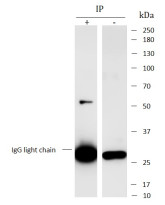ARG44683
anti-ING1 antibody
anti-ING1 antibody for Immunoprecipitation,Western blot and Human,Mouse
Overview
| Product Description | Mouse Monoclonal antibody recognizes ING1 |
|---|---|
| Tested Reactivity | Hu, Ms |
| Tested Application | IP, WB |
| Host | Mouse |
| Clonality | Monoclonal |
| Isotype | IgG2b |
| Target Name | ING1 |
| Antigen Species | Human |
| Conjugation | Un-conjugated |
| Alternate Names | p47ING1a; p24ING1c; Inhibitor of growth protein 1; p33ING1b; p33ING1; p47; p33 |
Application Instructions
| Application Suggestion |
|
||||||
|---|---|---|---|---|---|---|---|
| Application Note | * The dilutions indicate recommended starting dilutions and the optimal dilutions or concentrations should be determined by the scientist. |
Properties
| Form | Liquid |
|---|---|
| Purification | Protein A purification |
| Buffer | PBS with 0.09% sodium azide |
| Storage Instruction | For continuous use, store undiluted antibody at 2-8°C for up to a week. For long-term storage, aliquot and store at -20°C or below. Storage in frost free freezers is not recommended. Avoid repeated freeze/thaw cycles. Suggest spin the vial prior to opening. The antibody solution should be gently mixed before use. |
| Note | For laboratory research only, not for drug, diagnostic or other use. |
Bioinformation
| Database Links | |
|---|---|
| Gene Symbol | ING1 |
| Gene Full Name | inhibitor of growth family, member 1 |
| Background | This gene encodes a tumor suppressor protein that can induce cell growth arrest and apoptosis. The encoded protein is a nuclear protein that physically interacts with the tumor suppressor protein TP53 and is a component of the p53 signaling pathway. Reduced expression and rearrangement of this gene have been detected in various cancers. Multiple alternatively spliced transcript variants encoding distinct isoforms have been reported. [provided by RefSeq, Jul 2008] |
| Function | Cooperates with p53/TP53 in the negative regulatory pathway of cell growth by modulating p53-dependent transcriptional activation. Implicated as a tumor suppressor gene. [UniProt] |
| Cellular Localization | Nucleus. [UniProt] |
| Calculated MW | 47 kDa |
| PTM | N-glycosylation enhances cell surface expression and lengthens receptor half-life by preventing degradation in the ER. |
Images (2) Click the Picture to Zoom In







